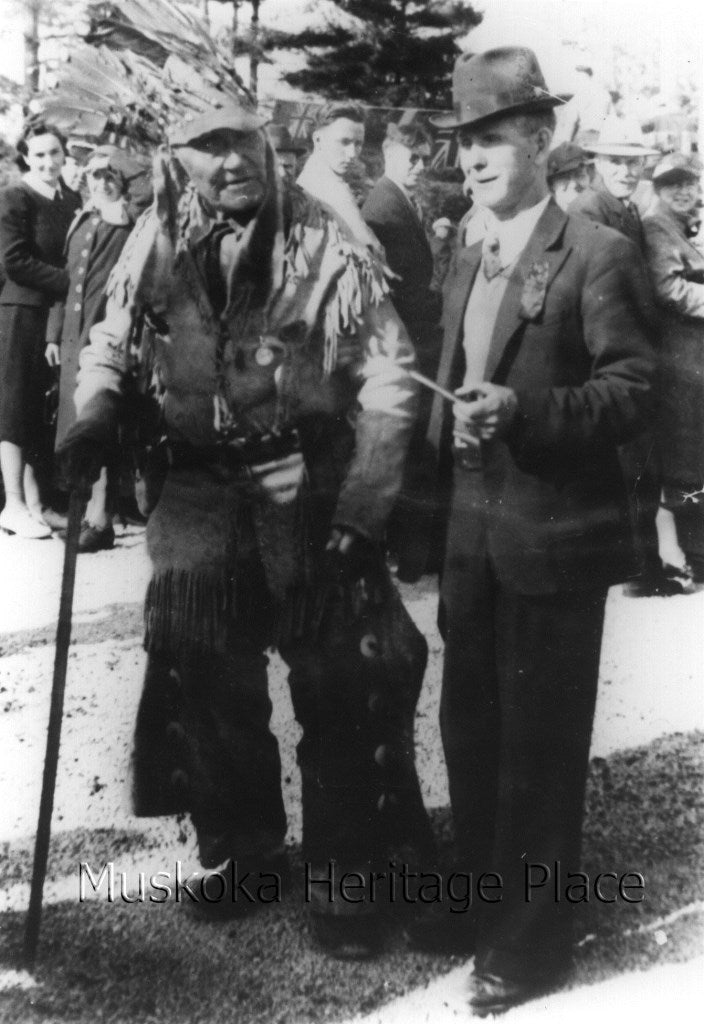
Person of Note – Chief John Bigwin
Article by J. Patrick Boyer
Hereditary chief John Bigwin, pillar of his Lake Couchiching community at Rama, was also home in Muskoka, his people’s hunting ground. Living with the land, Ojibwe women picked medicinal plants and berries while families summering at Trading Lake (Lake of Bays) raised vegetables around Cedar Narrows (Dorset). John grew potatoes on Bigwin Island until a control dam at Baysville raised the lake five feet and flooded out his spud patches.
They peeled bark from large birch trees to make canoes, baskets and vessels for holding liquids. Other peoples, without the high-quality bark, traded for coveted scrolls of it. With two trading posts, the lake was a place of meeting, sharing and living in a good way.
Especially, Muskoka was a spiritual realm. John cherished its water, rocky hills, and forests. The largest island bore his father’s name, Chief Joseph Bigwind, though known as Bigwin, a version of the name he used. As the burial place of his father, the ground was hallowed.
The first non-Indigenous traders who came to Muskoka in the 1840s were sustained by Ojibwe food. Then more came, exploring and settling. Encroaching upon Ojibwe territory, foreigners claimed what seemed to be unowned as their own, signing treaties and introducing reserves, poorer land on which to shunt First Nations to the margins. Joseph Bigwind, Chief Musquakie, and John Bigwin all signed treaties to accommodate the new realities. Over his lifetime, John witnessed most Ojibwe land become today’s Simcoe and Victoria counties and the District of Muskoka.
Chief John Bigwin defended the rights of Ojibwe families whenever they were infringed on by settlers or governments. Seemingly inseparable from his headdress, buckskin clothing and beadwork, he represented in words and symbols First Nation ways to non-Indigenous society. Alongside Rama’s elected chief and council members handling day-to-day government, he provided a potent symbolic connection to Anishinaabeg traditions, declaring “I will always fight for justice for my people.”
On festive occasions in Orillia, Bracebridge and Huntsville, settlers thrilled to glimpse his ceremonial drum-dance and feather headdress. The chief knew his appearance, in Muskoka’s period of Indian Tourism, provided an entrée to non-Indigenous folk. But he was no actor sent from Central Casting. Chief Bigwin used these openings to tell stories and “teach people well.”
When events demanded it, he deployed his authentic presence for maximum impact. In 1938, the centenarian in full regalia appeared in an Orillia courtroom to defend members of his community against charges of unlawful fishing. Holding up a parchment bearing regal signature, he read aloud its guarantee that his people could hunt and fish “for as long as the grass grows and the river flows.” In the hushed chamber, looking gravely into the judge’s eyes, John Bigwin solemnly asserted, “You must not harm my children.” The charges were dismissed.
In Bracebridge, Chief Bigwin sat in full regalia below the falls or near the library, a self-scheduling attraction, recounting “Indian stories” for tourists and wide-eyed children. Twice he travelled to Ottawa to urge Prime Minister Mackenzie King to uphold treaty rights. Royals were entranced by Chief Bigwin, who accompanied Prince Edward from Gravenhurst’s train station when the future king visited Muskoka. In 1938, he greeted Lord Tweedsmuir when the Governor General retraced Samuel Champlain’s 1615 route down the Trent-Severn waterway. In 1939, the King and Queen saw him as their royal tour train stopped at Washago.
John Bigwin, like his people, had to live in both Indigenous and settler worlds. He and Huntsville industrialist C.O. Shaw would spend days together, talking and walking Bigwin Island. When Shaw bought the island and built Muskoka’s most prestigious summer resort, Bigwin Inn had Indigenous motifs throughout. Shaw promised John land with his ancestors for his own burial.
Bigwin outlived both of his wives and their children. Following his death in 1940, the chief’s remains were not brought to his Muskoka home for burial as planned but interred instead in an Orillia cemetery.
By living for more than a century after his 1838 birth, Bigwin filled his time on earth – 1,223 moons, as measured by those to whom he was patriarch; to settler society, a month shy of 102 years – in such vital ways that his place in Muskoka heritage endures to this day.
For years he’d canoed from Lake Couchiching up the arduous Black River to Trading Lake, where he bartered furs and hides himself. He’d acquire some en route, from settlers at places like Vankoughnet, where he ate supper in the Boyes family’s home.
Offered a bedroom for the night, the chief declined. “I will sleep outdoors.” John Bigwin would not be confined. He would study the stars, feel the breeze against his face, inhale Muskoka woodland scents and remain grounded in who he truly was.
